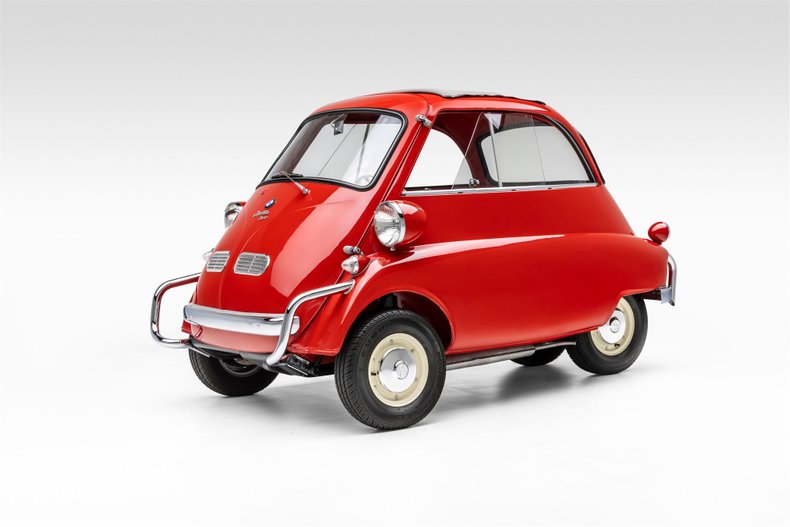
The BMW Isetta, often dubbed as the “bubble car,” stood as a testament to innovative design and adaptability in the face of adverse circumstances. The 1960 model, in particular, marks a significant chapter in the long and storied history of this vehicle and its pivotal role in the post-war European economic recovery.
Origins and History:
The Isetta was initially conceptualized by Italian manufacturer Iso SpA. Its name was derived from “Iso” and “etta,” the latter a common Italian diminutive, which together meant “little Iso.” The original design was a compact, affordable car suitable for the cash-strapped, fuel-conscious European market recovering from the war. The car had a distinctive egg shape, a single front-opening door, and an economical two-stroke engine.
BMW, teetering on the edge of bankruptcy in the early 1950s, saw the potential of the Isetta design as an affordable, compact vehicle that could appeal to the masses. After obtaining a license from Iso SpA, BMW set out to make the Isetta its own. The Italian two-stroke engine was replaced with a more reliable and powerful four-stroke motorcycle engine from BMW’s own production line. The car was reengineered to meet German standards of comfort and durability, and the first BMW Isetta rolled out of the factory in April 1955.
The BMW Isetta quickly became popular with the public for its affordability, reliability, and fuel efficiency. In the wake of the Suez Canal crisis of 1956, which resulted in fuel shortages and rationing, the Isetta’s incredible fuel economy of around 3 liters per 100 kilometers became even more attractive.
As the 1960s dawned, the Isetta had carved out a niche for itself in the automotive market. Despite the rise of larger, more powerful cars during this period, the Isetta maintained its appeal, especially among urban dwellers who valued its compact size and maneuverability in city traffic and tight parking spaces.
1960 BMW Isetta Specifications:
The 1960 BMW Isetta continued to use the 247cc single-cylinder, four-stroke engine that BMW had incorporated into the design from the start of their production. The engine produced about 12 horsepower, enough to drive the lightweight Isetta at speeds up to 85 kilometers per hour (approximately 53 miles per hour). While these figures may seem modest today, they were quite adequate for the vehicle’s purpose and the conditions of the time.
The car’s distinctive shape and design remained largely unchanged. The Isetta still boasted its unique single front-opening door and compact, egg-shaped body. Its small size, measuring just 2.285 meters in length and 1.37 meters in width, made it perfect for navigating and parking in crowded city streets.
The interior of the 1960 Isetta, while small, was surprisingly comfortable. The vehicle could seat two adults, with a bench seat and a surprisingly spacious headroom thanks to the tall, bubble-like shape of the cabin. The interior was simple and functional, in keeping with the car’s philosophy of practicality and economy.
For the suspension, the 1960 Isetta featured a simple, robust setup. The front suspension was independent, utilizing a leading arm and coil springs. At the rear, a semi-elliptical leaf spring was attached directly to the swing arm that held the engine and the rear wheel.
The Isetta was equipped with drum brakes on all wheels, a typical setup for cars of that period. Despite the modest power output of the engine, the lightweight Isetta was able to provide adequate stopping power.
Legacy and Impact:
The 1960 BMW Isetta marked the midpoint of a remarkable journey. During its production run from 1955 to 1962, the Isetta played a crucial role in helping BMW recover from financial difficulties, paving the way for the company’s subsequent success in the automobile industry. Moreover, it helped popularize the concept of microcars and demonstrated that small, efficient vehicles could be both practical and appealing.
Even after its production ended, the Isetta’s influence persisted. Its legacy can be seen in the design philosophy of modern city cars, which prioritize compact dimensions, fuel efficiency, and maneuverability. Additionally, the Isetta has become a favorite among vintage car collectors, valued for its distinctive design and historical significance.
In conclusion, the 1960 BMW Isetta embodies a fascinating chapter in automotive history, capturing a time of innovation, resilience, and change. It serves as a reminder of the enduring appeal of simplicity, efficiency, and practicality in automobile design, values that continue to be relevant in the face of modern challenges such as urban congestion and environmental concerns.
